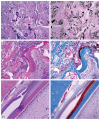Spontaneous Peripheral Ameloblastic Odontoma in a Male Sprague-Dawley Rat
- PMID: 28503263
- PMCID: PMC5426507
- DOI: 10.5487/TR.2017.33.2.141
Spontaneous Peripheral Ameloblastic Odontoma in a Male Sprague-Dawley Rat
Abstract
Peripheral ameloblastic odontoma is a rare variant of odontogenic tumor occurring in the extraosseous region. The present report describes a spontaneous tumor in male Sprague-Dawley (SD) rats. The clinically confirmed nodule in the right mandibular region was first observed when the rat was 42 weeks and remained until the terminal sacrifice date when the animal was 48 weeks of age. At necropsy, a well demarcated nodule, approximately 2.5 × 2.0 × 2.0 cm, protruded from the ventral area of the right mandible. The nodule was not attached to mandibular bone and was not continuous with the normal teeth. Histopathologically, the tumor was characterized by the simultaneous occurrence of an ameloblastomatous component and composite odontoma-like elements within the same tumor. The epithelial portion formed islands or cords resembling the follicle or plexiform pattern typical of ameloblastoma and was surrounded by mesenchymal tissue. Formation of eosinophilic and basophilic hard tissue matrix (dentin and enamel) resembling odontoma was observed in the center of the tumor. Mitotic figures were rare, and areas of cystic degeneration were present. Immunohistochemically, the epithelial component was positive for cytokeratin AE1/AE3 (CK AE1/AE3), and the mesenchymal component and odontoblast-like cells were positive for vimentin, in the same manner as in normal teeth. On the basis of these findings, the tumor was diagnosed as a peripheral ameloblastic odontoma in an extraosseous mandibular region in a SD rat. In the present study, we report the uncommon spontaneous peripheral ameloblastic odontoma in the SD rat. We also discuss here the morphological characteristics, origin, histochemical, and immunohistochemical features for the diagnosis of this tumor.
Keywords: Ameloblastoma; Odontogenic ectomesenchyme; Odontoma; Peripheral ameloblastic odontoma; Sprague-Dawley rat.
Figures




Similar articles
-
Spontaneous mandibular follicular ameloblastoma in a female Sprague-Dawley rat.J Toxicol Pathol. 2024 Jan;37(1):39-43. doi: 10.1293/tox.2023-0072. Epub 2023 Nov 13. J Toxicol Pathol. 2024. PMID: 38283374 Free PMC article.
-
Immunohistochemical observations on a possible ameloblastic fibro-odontoma.J Oral Pathol Med. 1996 Feb;25(2):93-6. doi: 10.1111/j.1600-0714.1996.tb00200.x. J Oral Pathol Med. 1996. PMID: 8667264
-
Ameloblastic fibroma and related lesions: current pathologic concept.Oral Oncol. 1999 Nov;35(6):535-40. doi: 10.1016/s1368-8375(99)00039-1. Oral Oncol. 1999. PMID: 10705086 Review.
-
Spontaneous complex odontoma in a Sprague-Dawley rat.J Vet Med Sci. 2002 Mar;64(3):289-91. doi: 10.1292/jvms.64.289. J Vet Med Sci. 2002. PMID: 11999454
-
Ameloblastic Fibro-Odontoma in an Adolescent: A Case Report and Review of Literature.J Clin Pediatr Dent. 2018;42(6):458-460. doi: 10.17796/1053-4625-42.6.10. Epub 2018 Aug 7. J Clin Pediatr Dent. 2018. PMID: 30085878 Review.
Cited by
-
Odontoameloblastoma with extensive chondroid matrix deposition in a guinea pig.J Vet Diagn Invest. 2018 Sep;30(5):793-797. doi: 10.1177/1040638718794784. Epub 2018 Aug 22. J Vet Diagn Invest. 2018. PMID: 30132419 Free PMC article.
-
Spontaneous mandibular follicular ameloblastoma in a female Sprague-Dawley rat.J Toxicol Pathol. 2024 Jan;37(1):39-43. doi: 10.1293/tox.2023-0072. Epub 2023 Nov 13. J Toxicol Pathol. 2024. PMID: 38283374 Free PMC article.
References
-
- Kramer IRH, Pindborg JJ, Shear M. Histological typing of odontogenic tumours. 2nd edition. Springer-Verlag Heidelberg; New York: 1992. World Health Organization (International histological classification of tumours) - DOI
-
- Weber K. Induced and spontaneous lesions in teeth of laboratory animals. J Toxicol Pathol. 2007;20:203–213. doi: 10.1293/tox.20.203. - DOI
-
- Nold JB, Powers BE, Eden EL, McChesney AE. Ameloblastic odontoma in a dog. J Am Vet Med Assoc. 1984;185:996–998. - PubMed
LinkOut - more resources
Full Text Sources
Other Literature Sources
Research Materials
Miscellaneous

